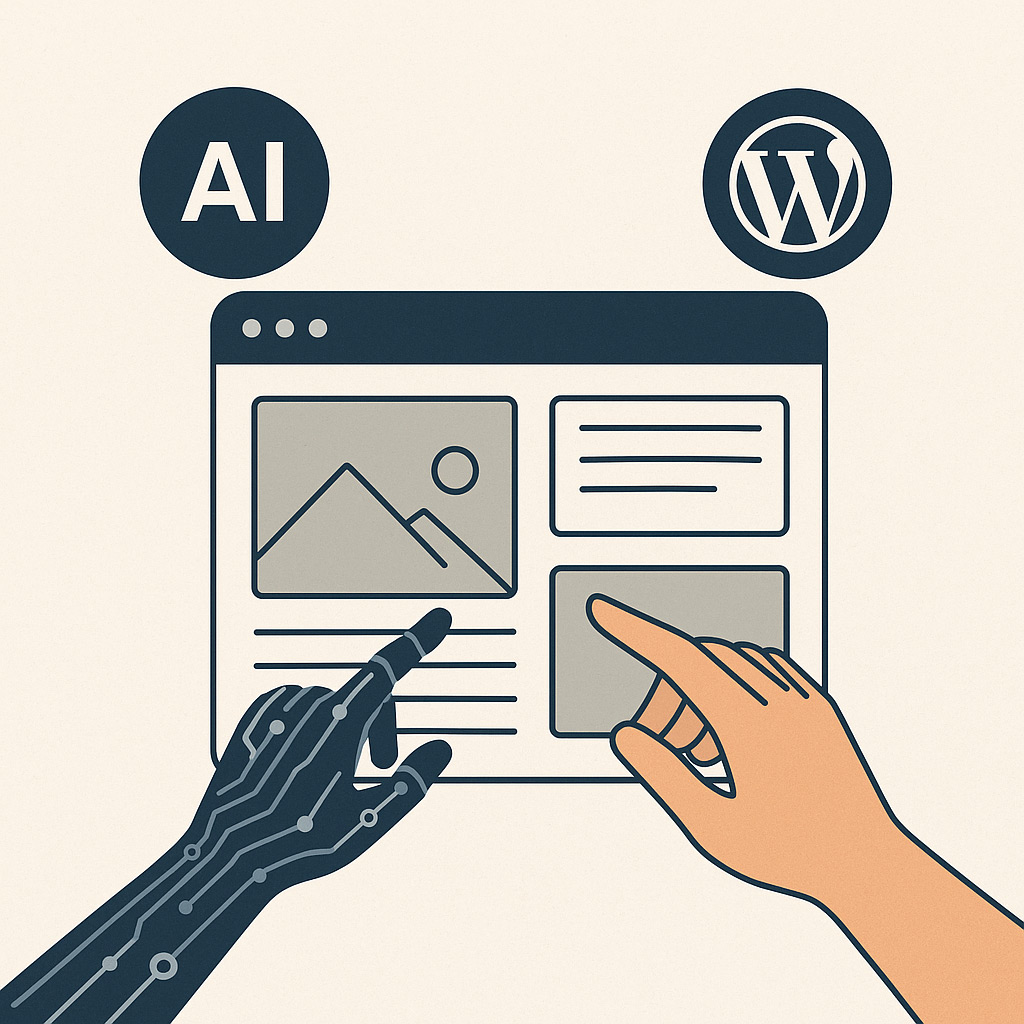WordPress has always been a platform about people—about making publishing, design, and development more accessible to everyone. But today, we’re staring down the next major shift: AI isn’t just knocking on the door. It’s already inside, quietly reshaping how we work.
The question now is: how will WordPress evolve with it?
We’re Already Seeing the Cracks—and the Opportunities
AI isn’t some abstract future. Tools are already helping people write posts, generate layouts, refactor code, and build full prototypes. Some of this integrates directly into WordPress—like block pattern generators or AI-driven content suggestions. Other times, it happens outside the platform entirely.
The risk is clear: if AI workflows grow faster than WordPress evolves, users may outgrow the platform before it has a chance to adapt. But there’s just as much opportunity—if we pay attention and act early.
Content Workflows Will Get Turbocharged
For agencies, content production is often the bottleneck. AI can now draft, rewrite, translate, and even tone-tune content. That doesn’t mean we lose human editors—it means their job becomes editing for quality, not starting from scratch.
WordPress can play a critical role here—if it creates tools that integrate with this shift. Expect to see:
- AI-assisted post editors that help shape ideas and headlines
- Smart taxonomies and tagging based on content analysis
- Content style guides that adjust in real-time based on brand tone
Agencies should be thinking now about how to build workflows that embrace AI as a teammate, not a threat.
Themes and Design Systems Will Go “Adaptive”
Right now, AI tools are good at generating content—but less good at matching your brand. That’s changing fast. As design systems become more codified (especially via theme.json), AI can start to “learn” your visual style and make design decisions that fit.
Theming could evolve into something more dynamic:
- A base theme provides structure and rules
- AI generates variations that stay within your system
- Editors adjust layouts without breaking design integrity
Developers should prepare by leaning into tokens, scalable spacing systems, and predictable structure—not over-customization. The simpler and more structured your design system, the easier it is to extend with AI.
Developers Will Still Matter—But in New Ways
The fear is that AI will “replace developers.” But in reality, it will just replace boring, repeatable tasks—and that’s a good thing. The role of a WordPress developer will shift from “builder of templates” to “designer of systems and tools.”
You’ll still be needed to:
- Build custom logic and integrations
- Design block systems and UI flows
- Maintain accessibility, performance, and security
- Guide clients through the right choices—not just fast ones
To stay ahead, sharpen your thinking around architecture and strategy. Let AI handle the boilerplate—but stay in control of the logic that matters.
So How Do We Prepare?
- Lean into structure – Use
theme.json, design tokens, and clean block architecture to create systems AI can build on top of. - Design for reusability – Blocks, patterns, and templates should be flexible, not one-off.
- Stay curious – Test the tools. Learn what AI can and can’t do yet. Let it surprise you, but don’t give up control.
- Lead your clients – They’re hearing the AI buzz too. Show them how it enhances the process—not replaces the value you bring.
Final Thoughts
Developers, designers, content creators—we’re all going to see shifts in how we work. Tasks that once took hours might be done in minutes. What clients value may shift from execution to strategy. And the edge won’t come from how fast you can build, but from how well you can think.
The future of WordPress isn’t no-code, and it isn’t AI-only—it’s smart-code, powered by people who know how to steer it.
We’re not just building websites anymore. We’re building ecosystems AI can assist—but not lead. And that puts those of us who understand both code and context in a powerful position.
But that also means the code we write matters more than ever.
AI can generate snippets, write boilerplate, even scaffold a full plugin. But it doesn’t understand why your system needs to scale, or how your design tokens reflect a brand’s voice. That’s your edge. And the better your code is—clean, thoughtful, modular, and extensible—the better AI can support you instead of getting in your way.
This is the time to:
- Write components that are reusable and predictable
- Lean into patterns over hacks
- Document your thinking, not just your output
- Build systems that are worth being assisted
Great developers won’t be replaced—they’ll be amplified. But only if they build with clarity and purpose.
AI can follow patterns. You create them.
Stay adaptable. Stay thoughtful. That’s how we stay relevant.
